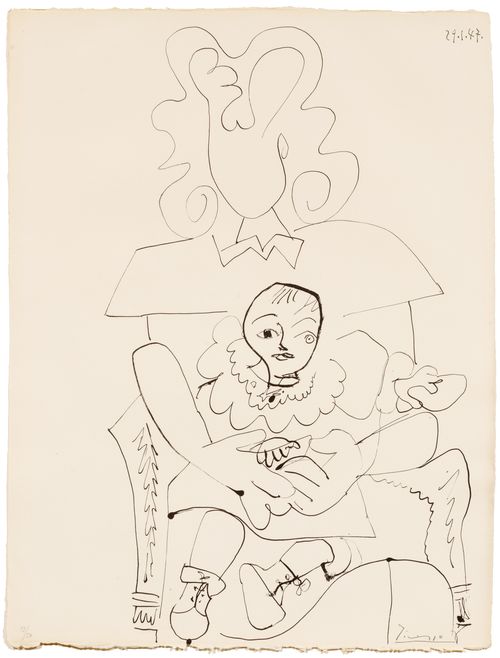
拍品 3612* - Z40 印刷品&多样性 - Samstag, 25. Juni 2016, 04.00 PM
PABLO PICASSO
(Málaga 1881 - 1973 Mougins)
Inès et son enfant.
1947.
Lithograph. 19/50. Signed lower right: Picasso, as well as dated in the stone top right: 29.1.47. Image 63 x 39 cm on vélin by Arches (with the watermark) 65.4 x 50 cm.
Catalogue raisonné: Bloch, no. 414.
Literature: Gauss, Ulrike (Hrsg.): Pablo Picasso. Die Lithographie. Graphikmuseum Pablo Picasso. Die Sammlung Huizinga, Münster 2000, no. 169.
The wide variety of possibilities deriving from the various printing processes enables Picasso to live to the full his propensity to experiment, thereby causing lithography to gain a particular status. Although engravings dominate his voluminous graphic oeuvre, lithography offers him a most crucial advantage: “the possibility to capture phases of work on which he can continue to work later on”. With regard to the paintings “Guernica” (1937) and “The Morgue” (1945), he took photographs of the various stages of their creation. Lithography permitted him to preserve each individual state of the work intact in spite of its further artistic transformation (as a duplicate).” (cit. Erich Franz, in: Exhibition Catalogue Münster, 2000, p. 10).
The following two lithographs „Inès et son enfant“ (“Inès and her child”), made in 1947, convey this unique quality of the lithograph and show in a striking way “how Picasso uses every possibility in order to do justice to his artistic perception and way of working, in order to let the work develop, to review its creation, to transform it and, sometimes, very seldom, to destroy it.” (cit.: Hachmeister, Heiner (ed.): Pablo Picasso. Paraphrasen und Variationen. Seltene Graphik, Münster 2004, p. 5.).
Based on the first state, Picasso creates entirely new works, whose kinship with the first state is evident, but which nonetheless exist as individual pieces.
Literature: Gauss, Ulrike (Hrsg.): Pablo Picasso. Die Lithographie. Graphikmuseum Pablo Picasso. Die Sammlung Huizinga, Münster 2000, no. 169.
The wide variety of possibilities deriving from the various printing processes enables Picasso to live to the full his propensity to experiment, thereby causing lithography to gain a particular status. Although engravings dominate his voluminous graphic oeuvre, lithography offers him a most crucial advantage: “the possibility to capture phases of work on which he can continue to work later on”. With regard to the paintings “Guernica” (1937) and “The Morgue” (1945), he took photographs of the various stages of their creation. Lithography permitted him to preserve each individual state of the work intact in spite of its further artistic transformation (as a duplicate).” (cit. Erich Franz, in: Exhibition Catalogue Münster, 2000, p. 10).
The following two lithographs „Inès et son enfant“ (“Inès and her child”), made in 1947, convey this unique quality of the lithograph and show in a striking way “how Picasso uses every possibility in order to do justice to his artistic perception and way of working, in order to let the work develop, to review its creation, to transform it and, sometimes, very seldom, to destroy it.” (cit.: Hachmeister, Heiner (ed.): Pablo Picasso. Paraphrasen und Variationen. Seltene Graphik, Münster 2004, p. 5.).
Based on the first state, Picasso creates entirely new works, whose kinship with the first state is evident, but which nonetheless exist as individual pieces.
CHF 10 000 / 15 000 | (€ 10 310 / 15 460)
以瑞士法郎銷售 CHF 13 700 (包含買家佣金)
所有信息随时可能更改。
